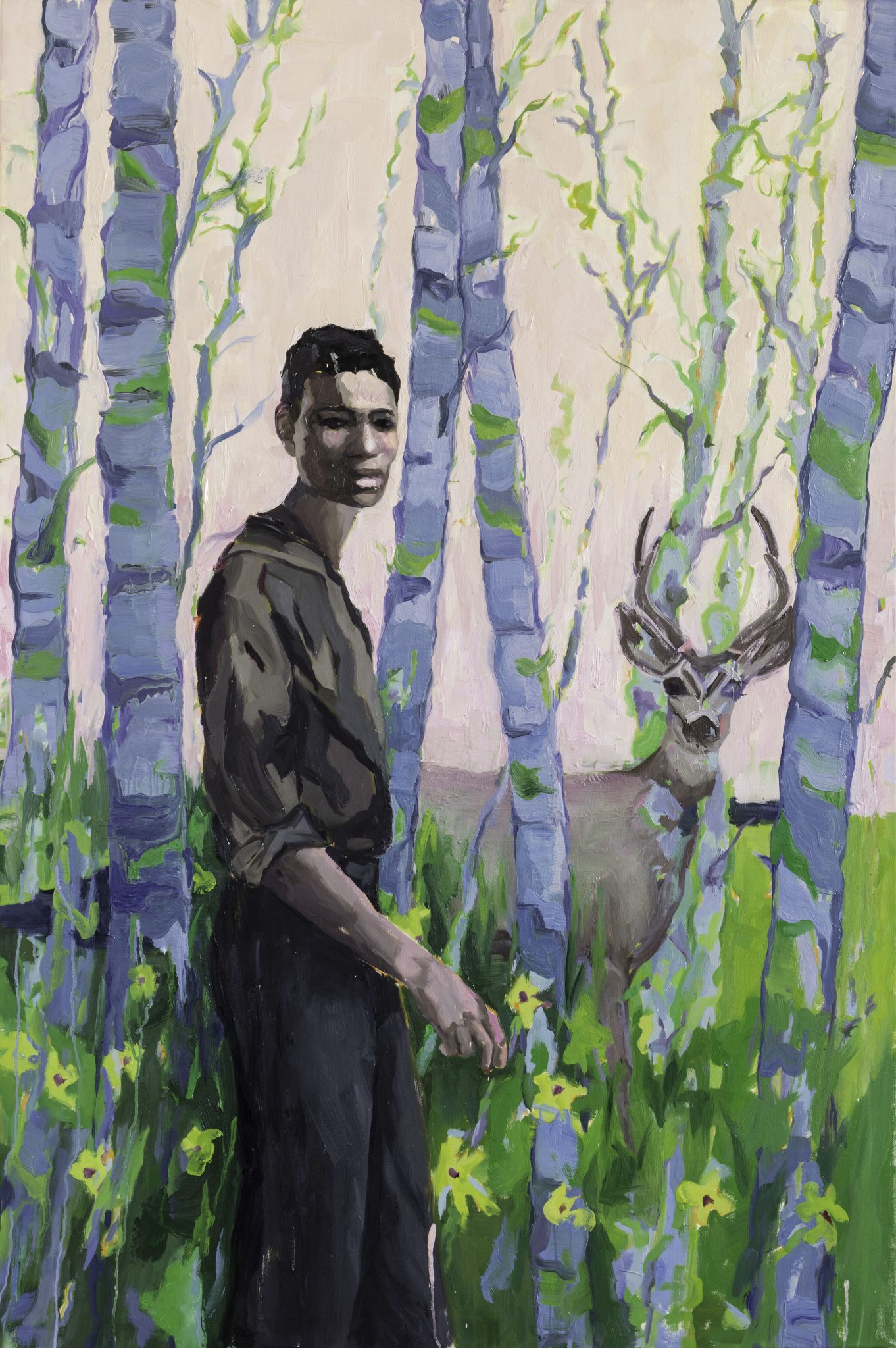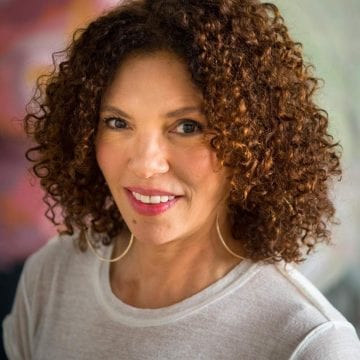The painting, Be Kind to Yourself, by Ruth Owens was recently on view at Ogden Museum of Southern Art as part of FOCUS. FOCUS is a new spotlight series featuring the work of both established and rising regional artists making an impact with their artistry. This series serves as a platform for artists to share their work and the important messages it conveys. We hope that FOCUS, as an ongoing initiative, will illustrate the powerful role art plays in the complex and vibrant fabric that is the American South.
Ruth Owens is a New Orleanian who after 25 years of practicing medicine, received a M.F.A. from the University of New Orleans in 2018. Owens was featured in Ogden Museum’s Louisiana Contemporary exhibition in 2019, and has completed artist residencies at the Addison Gallery of America, the Vermont Studio Center, The Joan Mitchell Center and she will go on to complete another at MASS MoCA this Fall.
Owens’ first large Julia Street exhibit, Be Kind To Yourself, is on view now at the Jonathan Ferrara Gallery through May 29.

Ruth Owens, Be Kind to Yourself, 2019, Oil on canvas, Courtesy of Jonathan Ferrara Gallery
 Q: Was art always prominent in your life? Or did it become an interest later in life?
Q: Was art always prominent in your life? Or did it become an interest later in life?
A: Art has always been in my life. As a child, music was the prominent art form for me. Growing up in Germany, my parents would take us to baroque chamber music concerts, classical music concerts and ballets. I also played piano, violin and the accordion. In high school, I became more interested in visual art after taking an art appreciation class. After this class, I started experimenting with creating my own conceptual art, but it wasn’t until college that I started formally drawing and painting. Even after college, I continued doing art on the side. I took classes at the New Orleans Academy of Fine Arts for years. I performed my last surgery in 2016 and then went to the University of New Orleans for my M.F.A. I loved my time at UNO. I already had the fundamentals of drawing and painting, but UNO helped me with my content and translating ideas.
Q: Where do you get your inspiration for your art?
A: My family is a big inspiration. In the 1960s and 1970s, my family purchased a Super 8 Film Camera. We made several family videos during that time. The videos would be from events like birthday parties or family vacations that took place in Germany and America. I have footage of my family at different lakes in Georgia and churches or cathedrals in Germany. A lot of history and concerns of African Americans have been erased over time, so it’s really important for me to preserve and present this film archive to illustrate our place in history. This archive is very important and inspires me.
Memory is also a big inspiration. When I think about memory, I think about personal and physiological memory and things that happen in familial relationships. Both subjects – the archive and memory – are a part of identity. Identity flows through both of these subjects. The identity I think about is not constrained by social constructs, there are no borders. Your identity doesn’t have to fit into a specific thing, I think of identity as more of a fluid thing. That’s why I feel my work is more expressionistic. In a lot of ways, it allows for a little bit of looseness and space for the viewer to inset themselves into the work. It also allows space for these subjects to move about and expand their identity in different directions.
Q: Ogden Museum recently showed your painting, “Be Kind to Yourself.” Can you tell us a little more about this piece?
A: When creating “Be Kind to Yourself,” I took a still from the film archive of my Dad in our backyard. I collaged it over a grove of aspens, with a white-tailed buck in the back. I played around with the color and drawing, and this became my composition. The main inspiration for this painting was the film. While watching these family films, I realized what a rare thing it was to have this documented narrative. More specifically, I realized how rare it was to have film of a Black family during the 1960s-1970s. Not only was film expensive, the camera was expensive, and you also needed to have our own projector to watch it. It’s rare footage.
Q: What does your work aim to say?
A: I’m not trying to say anything when I paint. I’m concerned with aesthetic and producing something that is visually attractive and can give visual pleasure. A lot of times I think about color when I work. Being concerned with aesthetic and mark making is layered on top of the content of the archive film and memory.
Q: Who are your biggest influences?
A: My family, my daughters and my son are a huge influence. I run most of my work by my children, especially my oldest daughter Madeline who is my biggest cheerleader. My children have helped many times pinpoint what might need to be added or changed on a current piece.
In terms of artists, I like Njideka Akunyili Crosby. She is an amazing painter who also deals with family as her subject matter. In many of her works, she is coming to terms with European influences in our society here in America. I also like Lynette Yiadom-Boakye. She is also an amazing painter. She paints from her imagination which produces stunning work. Both of these artists have enjoyed serious career success and have a great confidence in their vision.
Q: How would you describe your artistic style?
A: I would describe my style as somewhat expressionistic. I’m very interested in visual pleasure which is key to my desires in my work. I strive to achieve both a story and visual pleasure.
Q: What is your favorite medium and materials to use?
A: I am a painter and a video artist. Videography comes naturally because I have this family film archive and I want to do my best to preserve it. In my video, since the film is old and has been degraded, it is automatically an expressionistic presentation. These videos give me the sense of memory and psychological feelings. In my videos, I mix old film with new video, as you can see in my work “Good Family.” In this film, the contemporary footage is mixed with the Super 8 film footage. The contemporary footage and archival footage form a bit of tension or a contrast.
I also work with a lot of oil paint, which is the medium I feel most comfortable in. In my residency at the Joan Mitchell Center, I worked a lot with larger scale acrylic on paper.
Q: How has your medical career impacted the way you paint?
A: It gave me discipline to get up every morning and go into the studio whether I feel like it or not, whether I’m motivated or feeling inspired. I just have to go! It has also helped with drawing people. As a surgeon, I was able to understand the anatomy, muscles and different parts of the body. It has definitely given me an advantage in terms of being able to draw the body. Being a plastic surgeon, I was doing a lot of looking and seeing and now I’m able to translate that into a two-dimensional framework.
In my practice, I usually follow what Ernest Hemmingway did to keep himself on task. When I leave the studio, or in Ernest’s case his typewriter, I leave my work with a little bit undone. This helps when I arrive the next day, I know exactly where to pick up again. It helps me have a place to start, and once you start, it just starts to flow.
Q: What is something you are really looking forward to right now, either personally or professionally?
A: I have an upcoming exhibit on Julia Street at the Jonathan Ferrara Gallery, which is on view now through May 29th. There will be another opening reception on May 1 from noon to 7 p.m. CDC guidelines will be followed. This will be my first large Julia Street exhibit in a serious professional gallery. This is a huge landmark for me!
Q: What’s next for you? Where do you see your art taking you in the next couple years?
A: I’m going to continue to go to the studio every day. I have so many ideas for new paintings and videos that I’m excited to start working on. I am also finishing up a few commissions. In September, I’ll be doing a residency at MASS MoCA in Massachusetts, which I’m very excited about.
